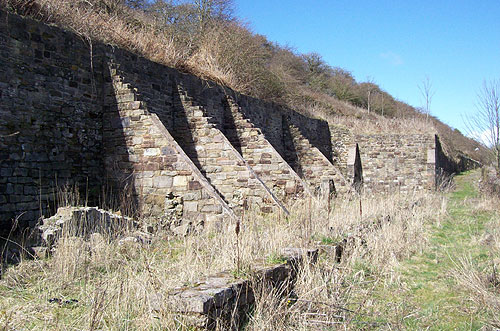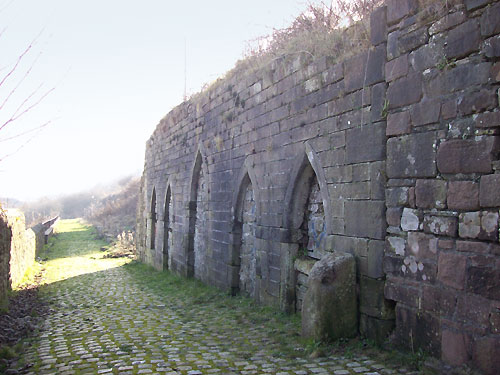
Newhouses was a sort of early social housing scheme provided by James Lowther for his workers. They were built in 1788 and consisted of three rows of small terraced houses built into the hillside above Whitehaven. They were accessed from Albion Street and Rosemary Lane and by steps from Preston Street, although when they were first built Preston Street did not really exist with just a road leading across the Castle Meadows from Newtown to the Ginns. All that remains now is just some ruins of one row of houses, but Newhouses had lasted about 150 years before the residents were moved out to the new housing estates, particularly Greenbank in the 1930's, and the houses were demolished in 1939.

Originally, it was conceived to build 500 of these houses to relieve the overcrowding of the town, in which the influx of miners to support Lowther's coal production had started to produce squalor. The well planned town with its wide streets, had found families living several to a room in tenement buildings created from warehouses or built in gardens and courtyards. The New Buildings or New Houses, as they became known even a century after they were built, were a nationally acclaimed solution to the problem and their building also provided extra jobs for numerous carpenters and masons.
The fact that they were built on the opposite side of the valley in full view of the Whitehaven Castle indicates that Lowther was proud of them, but would have had the equal property of reminding the miners who the boss was. He also provided the houses rent free to his miners, which initially seems very generous. However, this meant that he could get away with paying less wages and it encouraged the miners to stay at his pits rather than go elsewhere. This may also have played against him though, as other mine owners such as Curwen at Workington could afford to tempt away the Whitehaven miners with promises of much higher earnings. It is possible that this pay differential started the 'Jam Eaters' conflict between the two towns.
In the end only 266 houses were built in three rows, known as Front Row, Middle Row and Back Row with the town end of Middle Row being known as Castle Row. This may have been so named because it was opposite Lowther's House but may have alluded to a strange gothic style building on the end with a crenellated wall. What this building was, still puzzles everyone.

The wall can be seen here with the five Gothic style windows and doorways and the cobbled street of Castle Row at Newhouses. Michael Moon states with confidence in his book that it was some kind of medical facility and built to that style because such things had been formerly run by religious orders. In an old photo we can see that it had been at least two storeys high with another gothic window above the second arch and that it abutted the last house of Castle Row.
Another theory, extolled by Colin McCourt in his comprehensive book about Newhouses, is that it was once the laboratory of William Brownrigg for his study on mine gases. Although he originally requested from Lowther to build a 'hut' for his experiments, we know Carlisle Spedding piped gas to it and that it contained furnaces and so must have been more than the garden shed that description brings to mind. There is a lead plug at one corner that could have been the gas pipe and the stone post at the corner appears to be what such a gentlemen might use to mount his horse. As Carlisle Spedding was not only a mining engineer but the builder of St. James church, the ornate windows would be well within his capability. If as a doctor Brownrigg used it as a makeshift hospital, when miners were injured or sick, that could be the purpose gratefully remembered in folk memory, rather than the scientific pursuits it was built for.
There seems to be no actual evidence that it was anything more than just an ornate wall at least since the beginning of the 19th century. This leads to a further possibility that it was exactly what it looks like - a small chapel or monastic building that had been in ruins for many years before the Newhouses were built. The history of Albion Street just around the corner suggests that there was once monks living there in the time of Prior Alanby, in the early 16th century. However, in Read's paintings of the 1730's there is no building in this location although there are trees that may have obscured a ruin.
Newhouses seem to have originally been one up, one down, houses built of stone with a small yard at the back but these yards were later slated over to provide an extra, small rear room. This meant that the roofs of the houses on the front two rows then reached to the street behind. Without proper sanitation or drainage, epidemics of typhoid were a problem and the squalor became worse as time went on. After a damming health report in 1849 which described human excrement covering the streets, the 1850's saw piped water brought to shared stand-pipes and the 1860's saw sewers installed and the addition of outside toilets shared between groups of houses. Possibly this even contributed to the community spirit that grew up as it often does amongst people who have little else. This might be why people who later spoke of their childhood memories of the Newhouses seem to remember those times with fondness and good cheer.
© WAWL 2010